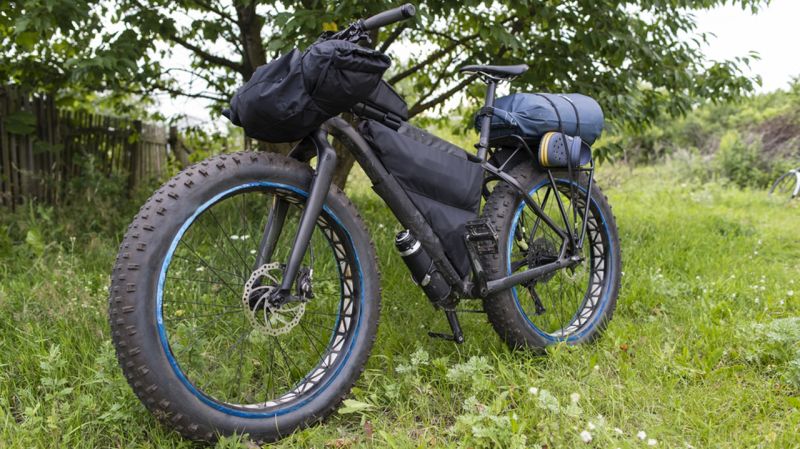WHAT IS BIKE PACKING?
Bikepacking is an exciting outdoor activity.
WHAT IS BIKEPACKING AND HOW DO YOU DIFFERENTIATE IT FROM TRADITIONAL CYCLING TOURS?
BIKEPACKING:
Bikepacking is an outdoor activity that combines cycling and camping. As a rule, you cycle through remote or wild areas over several days or weeks and spend the night on the way. This activity typically uses bicycles suitable for crossing wilderness, the mountains or other rough terrain. You also need to bring enough equipment and food with you. The focus is on light equipment and freedom to travel.
CYCLING TOUR:
Beim traditionellen Radtouren fahren die Meisten eine feste Route für eine lange Zeit, oft in Städten, Dörfern oder an Küsten, und zwar mit Fahrrädern, die eher für Straßen oder asphaltierte Straßen geeignet sind. Bei traditionellen Radtouren geht es mehr um Komfort und Vergnügen, mit kontrollierteren und gleichmäßigen Routen und Fahrzeiten. Und die Radfahrer entscheiden sich oft dafür, in Hotels oder Hostels zu übernachten, anstatt zu campen.
TABLE OF CONTENT
- Which bicycles are suitable for bikepacking trips and which are not?
- What equipment should you take with you when bikepacking?
- How to easily carry luggage when bikepacking?
- What should you pay attention to when camping?
- How should beginners plan their bikepacking tour with a bike?
- Summary
- Which bicycles are suitable for bikepacking trips and which are not?
TYPES OF BIKES SUITABLE FOR BIKEPACKING:
Gravel bikes: Gravel bikes are bicycles that combine the characteristics of racing bikes and mountain bikes. Their tires are wider than road bikes, narrower than mountain bikes, so they can adapt to different road surfaces and terrain, which is very suitable for bikepacking.
Touring Bikes: Touring bikes are also a good option for bikepacking. They are designed to carry more gear and supplies and handle different road conditions.
Mountain Bikes (MTB): With a stiffer frame and larger tires, mountain bikes are able to handle complex roads and rough terrain. These bikes are ideal for hiking and exploring in the wilderness, as well as for bikepacking.
TYPES OF BIKES NOT SUITABLE FOR BIKEPACKING:
Road Bikes: Road bikes have lightweight frames and narrow tires that can help riders go long distances faster, but they're not designed for rough terrain, so they're not among the best bikepacking bike options.
BMX bikes: BMX bikes usually have compact frames and tires and are suitable for trick riding, but not for long-distance touring and bikepacking.
E-bikes: E-bikes have to carry additional equipment like batteries, which add to the weight and bulk of the bikes, which is why they are not the best choice for bikepacking.
-
What equipment should you take with you when bikepacking?
- Sleeping Bag: A sleeping bag that will keep you warm and comfortable is essential, especially when temperatures are low at night.
- Tent: A tent offers you a private, secure space and protects you from the weather and wildlife.
- Cookware: Lightweight cookware allows you to cook your own food in the great outdoors.
- Water Bottle and Filter: Staying hydrated is essential in the great outdoors. Therefore, you need a water bottle to store water and a filter to filter and purify the water in the wilderness.
- Navigation System: In the wilderness you need an effective navigation system to find your destination and make sure you don't get lost.
- Lamps: Lamps allow you to see the way in the dark at night and can also illuminate your tent. Lightweight, durable lamps can make you more comfortable and safer outdoors.
- How to easily carry luggage when bikepacking?
The way you carry your luggage is very important when bikepacking by bike. Here are a few ways to carry your luggage.
- Top Tube Bag: A top tube bag is a convenient way to carry your luggage. It allows luggage to be stowed on the bike's top tube without sacrificing handling. If you have less luggage or if you need to get certain items out quickly, you can use this bag.
- Saddlebag: A saddlebag is a way to hang your luggage under the saddle of your bike. This will center the weight on the bike and keep the bike balanced. It is suitable for carrying light luggage such as tire repair gel and batteries.
- Frame Bag: A frame bag is a way of hanging luggage on a bicycle frame. It distributes the weight on both sides of the bike and keeps the bike balanced. It is suitable for transporting medium-weight luggage, such as groceries and water.
- Handlebar Bag: A handlebar bag is a way to hang luggage on the handlebars of your bike. It allows you easy access to your luggage, but you must be careful not to weigh too much of your luggage or it may affect the handling of your bike.
- Rack Bag: A rack bag is a way to hang luggage on the bike rack. It concentrates the weight on the rear of the bike and keeps the bike balanced. This method is suitable for transporting large pieces of luggage such as tents and sleeping bags. Whichever option you choose, you need to ensure the weight and stability of your luggage to avoid loosening or falling. Also, be aware of the size of your luggage so it doesn't interfere with your driving experience.
- What should you pay attention to when camping?
Camping is a relaxing and fun activity, but there are a few things to keep in mind to ensure your safety and comfort. Below are some points to keep in mind.
- Choosing the Right Campground: When choosing a campground, you need to consider the terrain and weather conditions. Choose a spot far from the road and avoid low-lying or flood-prone areas. When camping in winter or at high altitude, you need to keep warm.
- Food Storage: When camping, be mindful of how you store food to avoid infestation by wildlife. Keep food in airtight containers and away from tents and sleeping bags.
- Sleeping Bag and Tent: When purchasing sleeping bags and tents, you need to make sure they are suitable for your local climate and will provide you with adequate warmth and protection. When pitching your tent, you need to ensure that it is stable and firmly attached to the ground so that it will not collapse in strong winds or bad weather.
- Fire safety: If you want to use a fire for cooking or heating when camping, you need to pay attention to the safety of the fire. Set the fire in an open area and avoid placing flammable objects next to it. When leaving, don't forget to put out the fire and clean up.
- Observe local regulations: When camping, local regulations and laws must be observed. In some areas there may be restrictions or bans on camping, setting fires or other activities and these must be followed to avoid unnecessary trouble.
In summary, before you go camping, you need to prepare yourself carefully and make sure you know the local climatic conditions and regulations. If you follow the safety instructions and basic rules, you can enjoy a pleasant and safe camping experience.
- How should beginners plan their bikepacking tour with a bike?
Set the route and route: Before planning your bikepacking by bike, you need to set the route and route. Choose a gentler route and avoid rough mountain trails. At the same time, you should consider your own fitness level and experience and then choose the route that suits you.
Prepare Equipment: Before the trip, you need to prepare the necessary equipment, including tents, sleeping bags, cookware, water bottles, lamps, etc. It is advisable to choose light, durable equipment and pack them in different bags for easy carrying and storage use.
Plan for food and water: When bikepacking, food and water reserves are very important. Plan the amount of food and water you need each day and choose foods and bottled water that are easy to carry. It is also important to pay attention to water sources and not to drink untreated water.
Protection from UV rays: When bikepacking, you often need to be exposed to the sun for a long time, so you must take care to avoid the damage caused by ultraviolet rays. Pack sun hats, sunglasses, sunscreen, and other sun protection products before you travel.
Learn to repair your bike: When bikepacking, your bike may break. Therefore, it is necessary to teach you some basic bike repair skills, like changing inner tubes, repairing chains, etc.
Adjust the seat height of your bike: Bikepacking is a long journey, so you need to adjust the seat height of your bike to avoid knee damage. The seat height should allow the heel to lightly touch the pedals and keep the knees slightly bent.
Packing: When bikepacking, it is important to pack the backpack properly and to keep important items in an easily accessible place. Important items should be placed in the front basket or backpack and secured with straps.
- Summary
Bikepacking is an exciting outdoor activity. Not only is it exciting and challenging, but it also allows us to enjoy the beauty and tranquility of nature. By planning and preparing the right gear, everyone can experience the joy of bikepacking by bike. However, we should not forget the importance of protecting the natural environment and respecting local regulations and cultural mores to ensure that the impact of our activities on the environment and communities is minimized. Above all, we should enjoy every moment of our journey and create unforgettable memories for ourselves.

